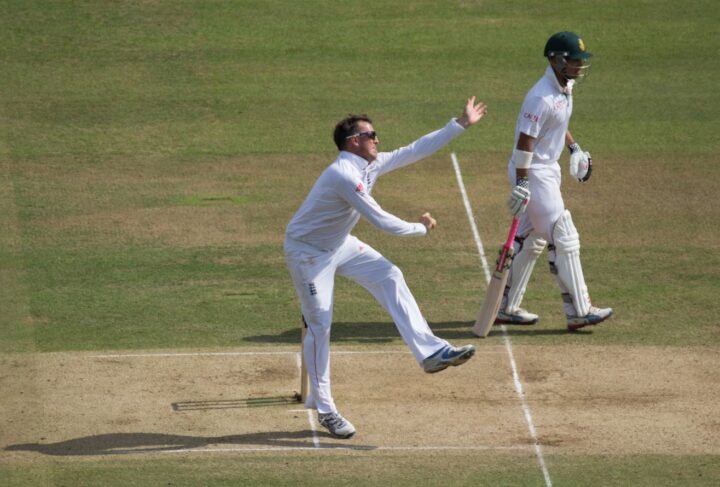“Say it ain’t so Joe” the little kid may have said to Baseball legend Shoeless Joe Jackson. Or Ray Liotta, depending on whether he had seen the movie “Field of Dreams” or not. What we do know is it has been repeated multiple times in a million schmaltzy Baseball books and films.
I am beginning to know how the kid felt. I am experiencing the same dream shattering unease about Cricket and the direction that its supposed guardians want to take it. Two imminent changes are at the root cause of my angst. These are namely the scheduling of an Ashes Test Match under lights and the MCC’s proposal to introduce Football and Rugby style red cards into the game. Today let’s focus on my doubts about red cards. There is time enough to bore you another day with my Victorian concerns about playing under lights. Ah’ cricket under gas lamps, maybe that is a compromise that could work altogether well for me.
The clamour for red cards has been out there for a while now. Why no yellow’s or a neutral and pacifying beige? Perhaps, a fetching shade of cerise would prove to be less aggressive than the warlike red. Only the MCC’s World Cricket Committee can answer that one.
The committee intends that a red card will be shown in response to “Threatening an umpire, physically assaulting another player, umpire, official or spectator; or any other act of violence”. There is no doubt that this is a well meant initiative. There is also no doubt that the famed Botham whisperer Mike Brearley (Chair of the Committee) is an intelligent and wise judge of the game as well as of human nature and behaviour. The problem is I just cannot see how it would work in practice.
When, as expected, the amendment to the Laws comes into effect in October 2017, many will see this change as a positive step. This is despite the game rubbing along quite nicely without any such deterrent for 229 years. It could realistically be judged that cricket is finally joining other 21st century sports in providing a proper deterrent to positively control conduct. However, this is exactly the problem with the proposal. Once controls and punishments are enshrined into the games law the battle for good behavioural standards is already lost. The sensible and central principal that the game is played by grown-ups, that the team captains control these grown-ups, under their charge, and that they in turn are answerable to the umpires, is gone.
Rather than a careful safeguarding for the future it is instead an admittance of defeat. The raising of a metaphoric white flag which signals that it is only with the threat of banishment from the field that players can maintain the minimum standards of conduct. The placement of draconian controls to prevent risks that do not or only minimally exist is a neat 21st century trick. It is the favourite pastime of many an auditor, compliance manager and politician all the world over.
Cricket is not a contact spot. Not between player and player at least. Although, anyone that has played the game knows that a ball propelled into your person, let’s keep it clean, at close range has the propensity to hurt a lot. Especially so if you were ever subjected to wearing the old 1950’s style spiked batting gloves or worse still the pink box, containing more holes than an emmental.
The risk of a loose tackle or an injudicious punch in a ruck does not exist in cricket. Professional cricketers do not come to blows on the field or engage in Soccer style pushing and shoving matches. It simply doesn’t happen in any meaningful sense. However imposing a red card system suggests that it could or it might and that is the real game changer. In attempting to protect the games standards we have inadvertently lowered them. We have accepted that punching officials and opposing players could happen and therefore measures need to be taken to protect against it.
Many will point to the amateur game where this sadly can happen and in fairness is the arena where the red card deterrent is felt by the MCC to be most required. Let’s not fool ourselves that the amateur game is all tea urns, sponge cake and crust removed sandwiches. In my years of club cricket I experienced lots of trash talk, posturing and boneheaded machismo; some of this even from the other team! But crucially not any actual fighting.
Of course lots of cricket is played across the world so it would be foolish to assume that it isn’t happening somewhere. The MCC stats make some grim reading in this area and clearly support this view. But the threat of a red card dismissal will ultimately change nothing. The general weakness in the amateur game is the reliance of players often to also act as umpires. This is a routine catalyst for accusations of sharp practice and bias towards one’s own team. Where neutral umpires are present behavioural standards generally improve but are still not always perfect.
The reality persists though that the new law would effectively have to be enforced by a player-acting-as-umpire or by a neutral volunteer umpire. I see that being fraught with very real difficulty. If a player is so uncontrollable that he has punched someone or is realistically threatening to punch someone – not the empty Hollywood handbags at dawn stuff that we have discounted above- then they will need to be removed from the field. If so… then, by whom? Probably not the umpire who is presumably collecting his teeth from the wicket to use as ball counters. More realistically it will be the same captain and team-mates that in the past we relied upon to self-enforce standards anyway.
The red card, based on the MCC’s explanation, is meant to be used only in response to the most severe physical transgressions. It will therefore do nothing to protect umpires or players against what is the very real bane of the amateur and to an extent professional game. This being the petty moaning and carping about umpiring decisions and the prevalence of aggressively overzealous and mostly unfunny sledging. The truth is that the lawmakers can do very little to change this. The true power and responsibility resides in the hands of every player that takes the field or coaches a youth team. They have the ability to set the standard and to act decisively against those that routinely transgress. Which, is not to say, that there is no place for banter and even a bit of niggle in the game. It would be much the poorer without it.
They say that life imitates art. Equally modern sport reflects modern life. It would be ridiculous to expect players to sign up to a code of behaviour from another century. It is not feasible to ask that. It is though feasible to expect players to take onto the field and uphold the basic standards of everyday life.
Cricket is a game played by only 13 people at any one time. Surely in the narrow realms of the cricket field 13 individuals are capable of policing themselves within the confines of the current Laws of Cricket, without extra and unenforceable sanctions?
Garry White









Red cards are pointless, the MCC know this but have done ‘something’ so they look like they are tackiling the issue. At the end of the day, participation is dropping and they have no idea how to recover it.
I can only go off what I hear when playing and from the many people who pay for my coaching.. sledging is the single biggest turn off for most players, the sheer volume of abuse and complete drivel that is allowed in the name of sport.
The second most common complain that is putting people off is over appealing for everything simply to ‘add pressure’ ‘make the umpire make a decision ‘ or simply ‘don’t ask don’t get’.
there appears to be no appetite to clean up the game from professional to amateur level in these two regards so behaviour will continue to decline. Modern society is aggressive and cares little for each other and that is reflected in the sledging. Some will say it’s always happened but I know more than enough older people who say is far more frequent and more vicious now that ever before. That is the sad reality and this red card system will do nothing to help that.
Physical stuff isn’t the issue.
I wonder how much Australia’s success in the 1990s and 2000s had to do with the rise of sledging? Not all good cricket teams have sledged after all. Because the likes of Merv Hughes, Ian Healey (and guys like Warne) used to destroy us so frequently, a perception grew that English cricketers were ‘soft’. Sledging was seen as part of Australians being ‘tough’ and therefore everyone wanted to copy them.
I agree sledging is unpleasant and not strictly necessary. Unfortunately it seems to have become more and more fashionable over the years. I don’t mind players having words now and again, especially if it’s comical and adds to the theatre, but it has gone over the top imho. Then again, it’s important to remember that the issue here (red cards) isn’t all about sledging.
No, hence why this red card stuff will literally have zero effect. I did out that at the start.
Would you sledge someone at work or in the street ? No, so don’t do it during cricket.
If you sledge and someone wraps a bat around your head then tbh, I have no sympathy as you’ve just been openly abusing them
Meanwhile, miss three drugs’ tests and nothing happens to you….
No need for red cards, clubs and leagues already have perfectly clear codes of conduct, it’s just up to the club and the league to police them properly.
It’s my experience that clubs that don’t apply their codes of conduct properly are the ultimate losers.
My club has a strict no sledging policy, and as as result we find it easy to attract players and have expanded from two teams to four teams in the past five years. Of the teams we played five years ago, the ones with the biggest mouths on the pitch are the ones who have folded in the following years.
You know what’s worse than being sledged? Being stuck on a team of dick head sledgers
But just think of the fun red cards could have produced in times past.
Mike Gatting being regularly red carded for flattening any unwary player who got between him and the tea table.
Inzaman penalised for reacting badly to the suggestion he should chase after a ball in the field.
And would the card have been brandished when Imran forgot where he was and cuffed a junior member of the team around the ears in mistake for his under butler?
And then there are the unfortunate incidents in the club game, such as one I remember where our skipper and opening bowler came to blows whilst the opposition looked on bemused……or the occasion when one of our fielders sent a spectator to hospital by failing to put the brakes on before their picnic on the boundary.